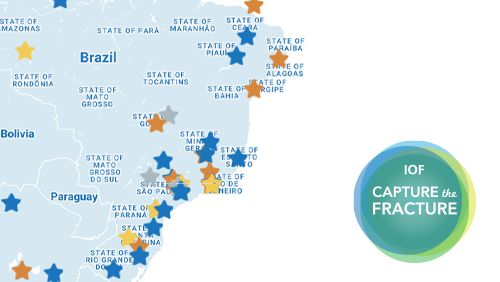Capture The Fracture FLS Mentors in Brazil publish guidelines for FLS implementation

A recent publication in Archives of Osteoporosis reviews the cost-effectiveness of Fracture Liaison Services (FLSs) and describes the key components for their effective implementation in Brazil.
Population ageing is occurring in most parts of the world. Latin America is the region where this demographic process will occur most rapidly between 2015 and 2030. Due to this trend, the number of fragility fractures in the region is also expected to increase. The report on epidemiology, costs and impact of osteoporosis published in 2012 by the International Osteoporosis Foundation (IOF) reported that, in Brazil, the number of hip fractures is expected to double by 2040, reaching almost 200,000 fractures per year and representing one fracture every 2.6 minutes. The enormous projected increase in the number of fragility fractures in Brazil shows that interventions to reduce the risk of fracture must become a health care priority.
The guidelines ‘How to initiate and develop Fracture Liaison Services (FLS): Recommendations from IOF Capture the Fracture® FLS mentors in Brazil’ outline the cost-effectiveness of FLSs in Brazil, and demonstrate to health professionals, hospital managers, and other stakeholders the importance of secondary fracture prevention. The review describes the fundamental components needed to establish an effective FLS, with methods of identification, investigation, and initiation of treatment, including pharmacological therapies for osteoporosis, supplementation, physical activity, fall prevention and follow-up. It also describes the team composition of FLSs, the value of regional clinical networks, and quality improvement, thereby providing guidance for Brazilian health professionals and decision-makers.
In Brazil, FLSs have been implemented since 2012, navigating the challenge of large geography and a complex health system. The authors highlight that, even with the limitations, restrictions, differences, and characteristics of each region, it is possible for health institutions to initiate an FLS, adapted to the available resources, and yet able to fulfil the stages of identification, investigation, treatment and follow-up.
Dr. André Manoel Inácio, corresponding author, concluded:
"The particularities or specific characteristics of the Brazilian health system mean that the implementation of Fracture Liaison Services (FLS) must be adapted to the local situation. However, despite the limitations, any attempt to recruit patients suffering from a fragility fracture is effective and reduces the risk of new fractures. We urge all hospitals caring for fracture patients to consider establishing an FLS to achieve better clinical outcomes for patients and to contribute to the prevention of secondary fractures in vulnerable patients."
In 2020, IOF launched the Capture the Fracture® (CTF) FLS mentor training programme in Brazil. Since then, mentors have received continuous training to support the development of new FLSs and to help existing FLSs become more efficient. In this context, the objective of the FLS mentoring group in Brazil was to publish their own experience to demonstrate that FLSs are a successful tool to close the gap in the treatment of fragility fractures, and that they are applicable to the Brazilian health system, with good results adjusted to the diagnostic and treatment options available in the country.
Since the start of the CTF programme in 2012 and until March 2022, 50 FLSs have been initiated in Brazil, of which 10 have improved their ranking on the Capture the Fracture® Best Practice Map. These FLSs are distributed in 28 cities throughout the country. Dr. Bernardo Stolnicki, lead author, who passed away in October 2021, is recognised as the pioneer of FLSs in Brazil.
"Dr. Stolnicki initiated the first FLS in the country at the Ipanema Hospital, contributing greatly to the advancement and diffusion of the implementation of Fracture Coordinating Units throughout the country. Thanks to his efforts, his orthopaedic colleagues have incorporated secondary fracture prevention into their clinical practice," said Monica Caló, regional manager of IOF LATAM and co-author of the review.
###
Reference: Stolnicki, B., Inácio, A.M., Tutiya, K.K. et al. How to initiate and develop Fracture Liaison Services (FLS). Recommendations from the IOF Capture the Fracture® FLS Mentors in Brazil. Arch Osteoporos 17, 63 (2022). https://doi.org/10.1007/s11657-022-01108-7
About Capture The Fracture®
Capture the Fracture® (CTF) is a multi-stakeholder initiative of the International Osteoporosis Foundation. It aims to drive change at local and international levels to make secondary fracture prevention a global reality. Since 2012, the CTF initiative has established global best practices for post-fracture care coordination programmes, such as Fracture Liaison Services (FLS). The Best Practice Framework (BPF) is a reference tool that clinics and hospitals can adhere to and through which to receive international recognition on the Capture the Fracture® Global Best Practice Map. In addition, CTF offers various resources and documents to drive quality improvement in FLSs. The CTF mentoring programme supports the initiation, development and sustainability of FLSs at the local level. https://www.capturethefracture.org/
To contact the mentors in Latin America write to monica.calo@osteoporosis.foundation